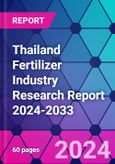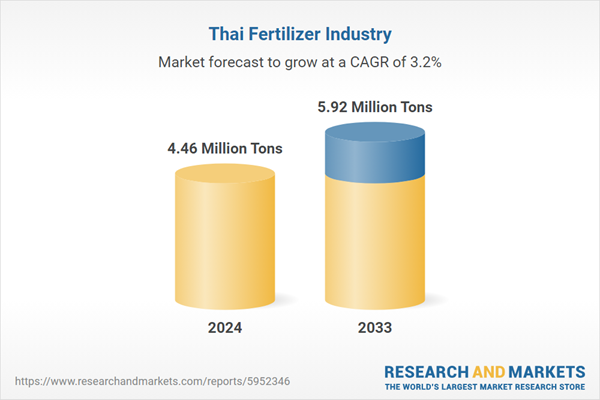Although the size of Thailand's agricultural land has not changed significantly in recent years, Thailand's agricultural productivity is growing rapidly, and this demand has led to an increase in the adoption of various agricultural products and technologies, promoting the development of Thailand's fertilizer industry.
According to World Bank data, Thailand's cultivated land area in 2021 was approximately 17.15 million hectares, accounting for 32.9% of the total land area. Among them, most of the farms are concentrated in the northeastern region of Thailand. The region suffers from poor soil quality, seasonality, variable rainfall, and scarcity of surface water. According to the publisher analysis, fertilization is crucial to improving agricultural productivity in Thailand. At the policy level, the Thai government supports farmers by providing agricultural input subsidies. In 2019, the government announced new incentives for Thai farmers in the form of cheap fertilizers. This will promote the application of chemical fertilizers in Thailand. In addition, as the price of fertilizers in Thailand has continued to rise since the beginning of 2022, the Thai government has introduced policies to limit fertilizer prices to maintain the stability of the domestic agricultural economy.
Rice crops dominate Thailand's crops, accounting for 41%, followed by rubber 28%; palm 12%; sugar cane 7%; feed corn 7% and pineapple 5%. These major crops in Thailand are generally fertilized with nitrogen fertilizers., and most soil in Thailand is deficient in nitrogen. Therefore, nitrogen fertilizer is the most commonly used chemical fertilizer in Thailand, especially urea. In 2021, Thailand’s urea imports accounted for 73.6% of Thailand’s fertilizer imports.
In 2020-2022, COVID -19 had a direct negative impact on the value chain of Thailand Fertilizer market . The main raw materials for the production of fertilizers include ammonium, sulfuric acid, phosphorus and potassium. Logistics obstruction has limited the supply of raw materials, and fertilizer prices have also affected the domestic fertilizer industry during the epidemic. The rise in fertilizer prices has a huge impact on a high-deficit country like Thailand, which basically relies on imports. According to the publisher analysis, Thailand's fertilizer industry has gradually recovered since 2023.
The concentration of chemical fertilizers in Thailand is moderate, and the participants mainly include companies such as Yara (Thailand) Company Limited, Haifa, Chai Thai Co. Ltd, Thai Central Chemical Public Company Limited and Saksiam Group .
The publisher predicts that with the development of Thailand's agriculture and planting industry, Thailand's fertilizer imports will gradually increase in the next few years. The publisher estimates that Thailand's fertilizer imports will be approximately 5.92 million tons in 2033, with a compound annual growth rate of approximately 3.2% from 2024 to 2033.
Topics covered:
- Overview of Thailand's Fertilizer Industry
- Economic environment and policy environment for fertilizers in Thailand
- Thailand's fertilizer market size from 2019 to 2023
- Analysis of major Thai fertilizer manufacturers
- Main driving forces and market opportunities of Thailand’s fertilizer industry
- What are the key drivers, challenges and opportunities for Thailand's fertilizer industry during the forecast period 2024-2033?
- What is the expected revenue of the Thailand Fertilizer market during the forecast period 2024-2033?
- What strategies are adopted by the key players in the market to increase their market share in the industry?
- Which segment of the Thailand fertilizer market is expected to dominate the market in 2033?
- Thailand Fertilizer Market Forecast from 2024 to 2033
- What are the main headwinds facing Thailand’s fertilizer industry?
Table of Contents
Companies Mentioned
- Yara (Thailand) Company Limited
- NFC Public Company Limited
- Chai Thai Co. Ltd
- Thai Central Chemical Public Company Limited
- Haifa Group
- SAKSIAM GROUP
- ICL Fertilizers
- Ranthai Agro Co. Ltd
- Rayong Fertilizer Trading Company Limited
- UBE Group
- COMPO Expert
- ICP FERTILIZER COMPANY
Methodology
Background research defines the range of products and industries, which proposes the key points of the research. Proper classification will help clients understand the industry and products in the report.
Secondhand material research is a necessary way to push the project into fast progress. The analyst always chooses the data source carefully. Most secondhand data they quote is sourced from an authority in a specific industry or public data source from governments, industrial associations, etc. For some new or niche fields, they also "double-check" data sources and logics before they show them to clients.
Primary research is the key to solve questions, which largely influence the research outputs. The analyst may use methods like mathematics, logical reasoning, scenario thinking, to confirm key data and make the data credible.
The data model is an important analysis method. Calculating through data models with different factors weights can guarantee the outputs objective.
The analyst optimizes the following methods and steps in executing research projects and also forms many special information gathering and processing methods.
1. Analyze the life cycle of the industry to understand the development phase and space.
2. Grasp the key indexes evaluating the market to position clients in the market and formulate development plans
3. Economic, political, social and cultural factors
4. Competitors like a mirror that reflects the overall market and also market differences.
5. Inside and outside the industry, upstream and downstream of the industry chain, show inner competitions
6. Proper estimation of the future is good guidance for strategic planning.

LOADING...
Table Information
| Report Attribute | Details |
|---|---|
| No. of Pages | 60 |
| Published | April 2024 |
| Forecast Period | 2024 - 2033 |
| Estimated Market Value in 2024 | 4.46 Million Tons |
| Forecasted Market Value by 2033 | 5.92 Million Tons |
| Compound Annual Growth Rate | 3.2% |
| Regions Covered | Thailand |
| No. of Companies Mentioned | 12 |









